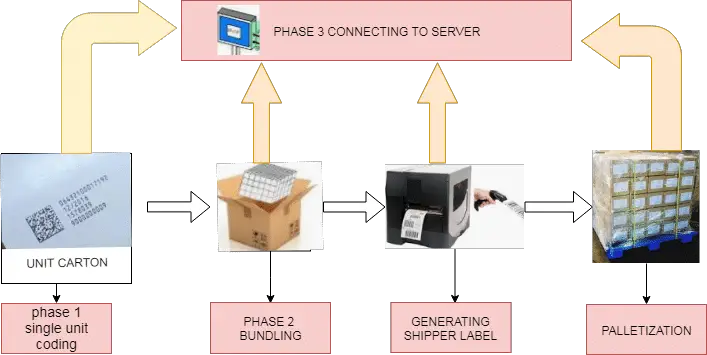Aggregation and Disaggregation is an important aspect of pharmaceutical industries to get a product to be serialized. Aggregation in a simple way is the process of making Groups bundles of serialized Products. A Group bundle contains information about the products throughout the supply chain. This process makes forms a hierarchical, parent-child relationship through the process of “aggregation.
“For example, during the Serialization of pharmaceutical products, printed cartons containing GTIN code or 2D Code are aggregated and Transferred into a Bundle or Box. At the same time, an online serialized label will be generated after the completion of the quantity as per packing specifications. During this, the same information will be transferred to the server for traceability.
In order to aggregate, the parent must be uniquely identified, either using the SSCC for logistical items or the GTIN + serialization (SGTIN) if the parent is a trade item.
Tertiary packages (bundle, case, pallet) are already being used by the pharmaceutical industry to streamline supply chain processes. By establishing parent-child relationships, this approach makes it simple to get the serial numbers of all packages contained within tertiary packages. By doing this, you can see the package’s and the pills’ serial numbers without having to open any other packages.
Disaggregation: The process of removing a carton from an aggregated bundle or box and replacing it with a new carton when an inspection system detects a problem is known as disaggregation.
Difference between aggregation and Disaggregation
Vision systems simultaneously read and verify each bottle or carton code or carton code at packaging stations. The system will print a bundle label using specialized printers and apply the label to the bundle once the total number of bottles or cartons in the bundle has been scanned and verified. The term for this is aggregation. The process of removing a bottle from an aggregated bundle and replacing it with a new bottle when an inspection system detects a problem is known as disaggregation.
Why is Aggregation So, Important in the Supply Chain
Every stage of the supply chain for serialized medicines must be documented in pharmaceutical track and trace systems. It would be simple to move medications through the supply chain one at a time. But among parties, pharmaceuticals generally move in tertiary containers like bundles, cases, and pallets. Each party in a supply chain without aggregation can only access serialized data contained in tertiary packages through arbitrary procedures. Aggregation is essential because it enables SSCL access to the serialization information of the product contained in tertiary packages. Thus, it makes supply chain operations possible.
Hierarchical Data While Aggregating
Hierarchical data are the results of establishing a parent-child relationship between two items. This framework, which we frequently employ in daily life, serves as the foundation for aggregate data. Pallets, cases, and cartons represent the hierarchical data in the diagram below. We use this information for pharmaceutical industry data aggregation processes.


